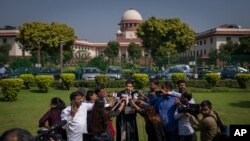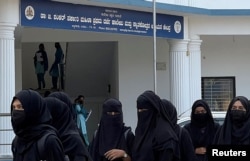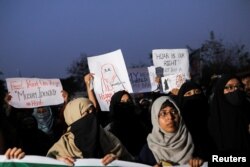A two-judge bench of India’s Supreme Court has expressed opposing views on whether students can wear the Muslim headscarf in classrooms, a contentious issue that had sparked widespread protests earlier this year and become a flashpoint over the rights of minorities.
The southern Karnataka state imposed a ban on students wearing the hijab in classrooms in February. It was challenged in the top court after another court upheld the government order on the ground that wearing the hijab is not an essential practice of Islam.
In the closely watched judgments delivered on Thursday, one judge said that authorities can enforce a uniform in schools, while the other held that the right to wear the hijab cannot be restricted by the state.
Justice Hemant Gupta upheld the ban saying that all communities should follow the dress code.
Justice Sudhanshu Dhulia on the other hand said that the high court took a wrong path by focusing on whether the hijab was an essential religious practice and wearing it was "ultimately a matter of choice - nothing more and nothing less."
He said that his focus was on education of the girl child, especially in rural areas and questioned whether the ban would make her life better.
Petitioners had expressed worries that girls might stop attending school if they were prevented from wearing the headscarf.
The issue will now go before a larger bench of three or more judges to settle.
The ban on the hijab in classrooms is not countrywide – it has only been enforced in Karnataka.
Following the split verdict, state authorities said that the ban will continue. “Our rules do not permit religious clothing inside the class,” Karnataka Education Minister B.C. Nagesh told reporters. Saying that “worldwide ladies are demanding they will not wear hijab, even in countries like Iran,” he expressed hopes that a verdict by a larger bench will support the ban.
Defending the decision to stop girls from wearing the headscarf, the state’s Hindu nationalist government had told the Supreme Court that its decision was religion-neutral and aimed only at promoting uniformity and discipline.
Critics however had slammed the order calling it an instance of marginalization of the country’s Muslim minority under the Bharatiya Janata Party. India is home to 200 million Muslims, who make up nearly 14 percent of the population.
The controversy erupted after a government-run school in Karnataka’s Udupi district had stopped Muslim girls from attending class wearing the hijab in December last year. After Muslim students staged protests, the issue took on a religious dimension as Hindu activists staged counterprotests, demanding that the saffron shawl, a Hindu religious symbol should also be allowed in schools.
Supporters of the ban said that it was within the jurisdiction of schools to set dress codes which should take precedence over any religious practice.
But rights advocates and activists say it violates the fundamental right to education and privacy. “The uniform can never be more important than education. In a democratic country, it is a matter of choice whether a girl student wears the hijab or not,” said Zakia Soman, co-founder of a Muslim women’s rights group called the Bharatiya Muslim Mahila Andolan.
Activists said that comparisons with the anti-hijab protests in Iran were misplaced because wearing the hijab is not mandatory in India.
“I agree that the hijab is a patriarchal imposition and is not mandatory in Islam. But for a girl to understand that she requires education,” said Soman. “That opportunity for that girl to educate and empower herself can be thwarted by the ban on hijab.”
She said the split verdict reflected a country that was becoming increasingly polarized on religious lines.
With the top court failing to settle the issue, the debate will likely continue to rock India in the months to come.









